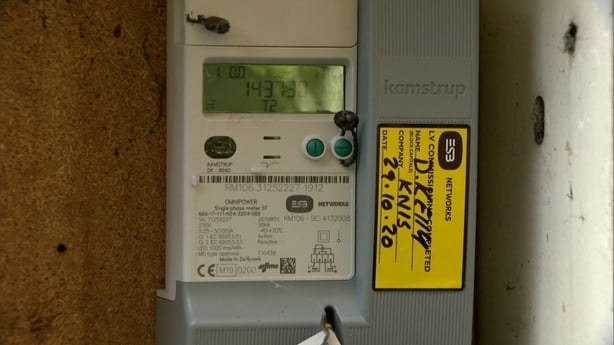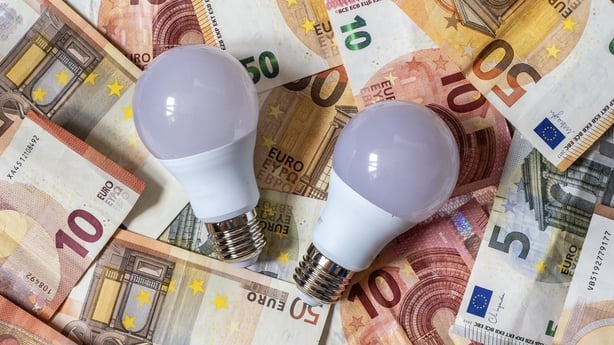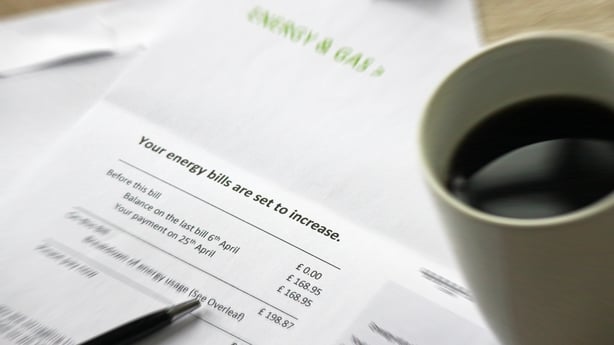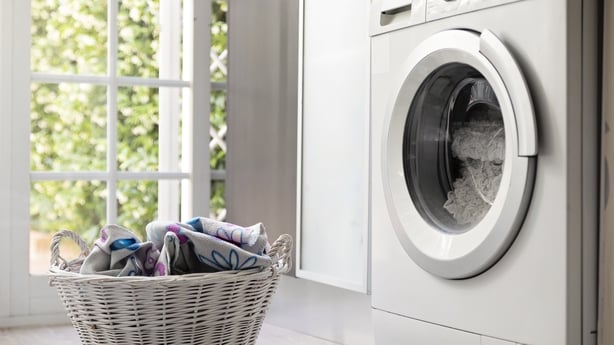While a growing number of homes now have smart electricity meters installed, many are still unsure about what the new system actually offers compared to an old-fashioned meter.
But getting the most out of a smart meter can be tricky, as the right price plan will differ depending on your situation.
Users may also need to relearn some of their household habits in order to fully benefit from the change-over.
What is a smart meter?
We need your consent to load this rte-player contentWe use rte-player to manage extra content that can set cookies on your device and collect data about your activity. Please review their details and accept them to load the content.Manage Preferences
A smart meter is a modern version of the standard electricity meter that's in every home in the country.
And it offers a number of differences over the old type of meter – though a lot of them are mainly going to help your supplier and the ESB.
Firstly, they continually feed your energy usage back to the ESB, so your supplier no longer has to estimate how much electricity you’re using at any time. That means you no longer need to give meter readings to ensure your bill is accurate.
It will also make it easier for the ESB to pin-point the location of faults – and identify which parts of the network need to be upgraded.
But that constant stream of information can also be useful to customers – because, in theory at least, a smart meter means you can also see a near real-time feed of your own usage through an app or website.
That means that you will eventually know how much energy you’re using at any point – so you’re less likely to suffer 'Bill Shock’ at the end of the month.
And that should also help you to better manage your usage – because when you’re running an energy hungry appliance, you’ll see that straight away, and see how much it’s costing you.
Switching supplier should be easier, too.
Finally - and this is a bit of a niche one – smart meters make it easier for people to sell electricity back to the grid.
That means that, for the small-but-growing number of homes that have solar panels, a smart meter could ultimately be a way for you to make money too.
But there are plenty of things that a smart meter can’t do.
Because of the name, people might mix it up with smart home appliances – like the bulbs you can control from your phone.
They’re a separate thing altogether to your smart meter.
How many smart meters are there in Ireland?

As of this week, there are just shy of 980,000 smart meters installed in homes across the country, according to the ESB.
The figure is likely to pass the million mark in the coming days.
The rollout was first announced in 2017 and got underway in 2019.
It was disrupted somewhat by Covid but the target is still to have smart meters in all 2.4 million homes across the country by 2024.
So still a long way to go – but within the next few months half of all homes in the country should have one installed.
If you have a smart meter, how do you make use of it?

What the ESB would say is that all smart meters are immediately useful – because simply having one feeding information back and forward is, in itself, a good use of one.
Beyond that, you don’t need to do anything else at the moment – if you don’t want to.
But having a smart meter also allows you to move over to different ‘smart tariffs’.
Generally that means that rather than having a single price on the electricity you use, no matter when in the day or week you use it, a smart tariff might offer electricity at a cheaper rate at certain times of the day, but a dearer rate at others.
Some suppliers offer a higher standard rate – but then you can choose one day on the weekend where your electricity is completely free.
But, according to recent figures from the Commission for the Regulation of Utilities, only 4% of people who had a smart meter installed had moved over to one of these plans.
So the vast majority, so far, are still using the old-fashioned, single rate through the day.
Aside from the smart tariffs, are there other ways customers might make use of their meter right now?

Well one supplier at the moment is offering ‘energy insights’ to smart meter customers, even if they’re not on a smart plan, which allows them to keep a closer eye on their usage, and get a better idea of what appliances are using the most energy.
And somewhere in the region of 60-70,000 customers are availing of that at the moment.
So that suggests that there are many customers who are engaged in the issue – and they’re paying attention to see if one of the smart plans might work for them.
The number of people tapping into this kind of information should grow soon, as the ESB is rolling out a ‘data hub’ service next month.
This will open to users on a phased basis, but everyone should have access by early next year, and this will allow customers to log in to a website and see their energy usage.
It’ll be minus one day – so your energy usage up to the night before, but it should be enough to help people see the trends in their usage, and where they can make changes.
After that we should also start to see apps coming along, probably from your utility, to make it even easier to access and monitor your usage.
It’ll be another year or two before you’re able to get near real time data.
Why is this launching next month? Why wasn’t it available from day one?
The simple answer to that is that the ESB didn’t expect there to be much demand for energy usage data when it first planned the rollout.
The rollout was planned before anyone was thinking about Covid, and certainly long before anyone thought Russia was going to invade Ukraine and set off the spike in energy prices that we’re dealing with today.
The actual installation of the meters is a big job in itself – so the plan was to just switch the meters over, let people carry on as before.
Once the installation work was done, they’d then go back and start working out the extra features, and pushing people towards smart plans.
But since then, things have changed dramatically – and trying to get households to change their energy habits has become far more important now than it would otherwise have been.
So why are so few households using smart plans?

There are probably a couple of factors at play in this.
For a start – Irish consumers aren’t very good at switching in general.
Even aside from smart meters a lot of people have, until now at least, been happy to stick with the supplier they have – even when a cheaper option is available, and easy to access.
The smart plans are also a bit of a muddle, too.
Users are going from a situation where a provider has a single price – take it or leave it – to a situation where each supplier might have four or five different options, with different prices for different times of the day, or days of the week.
And if you’re looking at that across multiple different suppliers, trying to figure out what might be the best option for you, it can get very confusing.
But another big factor is the fear of the unknown – because once you switch to a smart tariff, you can’t switch back.
People may be genuinely worried that they’ll move over to a smart plan, it’ll end up costing them more than their old plan but they won’t be able to do anything about it.
So could you end up paying more on a smart plan?
You could – it really depends on the plan you chose, but more importantly how willing or able you are to tweak your habits.
So taking Electric Ireland’s plans, for example. That’s the biggest electricity supplier in the market – so their offer is the one that the biggest proportion of customers will be looking at.
Their Standard Smart Tariff offers a different rate depending on the time of day.
Between 8am and 11pm, customers pay 43.1c per kilowatt hour. That’s almost 9% higher than Electric Ireland’s non-smart, standard tariff.
There’s now also an extra premium added to the peak hours of 5-7pm. That’s priced at 45.96c/kWh – so 16% higher than the non-smart tariff.
The pay-off for customers is that the night rate – from 11pm until 8am - is 22.65c/kWh. That’s an almost 43% discount on the regular tariff. So much, much cheaper.
But, of course, in your average home, things are winding down at 11pm. We wouldn’t normally have need for energy hungry devices like the washing machine or dryer at that time. And you’re advised not to put them on when you’re going to bed, either.
And on the flip-side of that, the normal habits of a home would see the cooker and the TV, and maybe the dishwasher or washing machine going on between 5-7pm – and on a smart tariff, that’s when you’re going to be charged the most.
So if you move to a smart tariff, but don’t change any of your habits, you may well end up paying more for your energy.
Is that just the reality of smart meters now?

The Irish Independent recently reported that the CRU – the utility regulator – was talking to energy companies here to try to understand why they had set the rates that they’ve set.
There is an expectation that, as more homes get smart meters, and more data flows in, and energy companies get a better idea of how customers are using their energy, there might be some better deals put together.
But the reality is that we know that part of the goal of the regulator and the energy operators is to try to push down demand at peak times, and spread it out over other parts of the day.
And the main way you’re going to do that is by penalising usage at peak times – and incentivising it at quiet times. Which means that if you’re on a smart tariff, you’re always going to have some kind of trade-off on what you’re being charged.
Ultimately how helpful or unhelpful smart meters are all boils down to whether people tweak their habits to try to deal with that – or even take advantage of that.
So, if you’re the kind of person who tends to say up late, maybe it’s about getting in the habit of putting the washer or dryer on in the hour before you go to bed.
Or maybe putting a wash on becomes the first thing you do in the morning if you get up early. Those smart day/night rates run until 8am, so a lot of people would be up well before then and be able to take advantage of that.
And, of course, the likes of your fridge-freezer – which is running 24-7, will be able to avail of the cheaper rate at night.
All things being equal, the average rate per hour is a bit less on a smart tariff than a standard one – so something that’s using a consistent amount of energy through the day will work out a bit cheaper than before.
Or you might even decide that you’re better off going for a tariff that gives you one day of free electricity a week. That way you can hold back all of your washing until then, and go gung-ho on it when Saturday or Sunday comes.
That might not be practical for some households, though.
Realistically, even making all of those changes, you may not see much of a saving. And your bill may still go up, especially compared to last year, but anything that people can do to soften the blow of price rises has to be seen as a win.
And if you look to the future you can see other ways that smart tariffs could benefit homes, too.
There’s a growing number of households with an electric car, and they’ll be able to benefit by setting their car to charge overnight.
Something that may become normal down the line is for a home to have a large battery of its own, too, maybe tucked away in the attic or a press somewhere. That could then charge up overnight, when the rate is low, and power some or all of your home during the day, when energy from the mains is more expensive.
If someone doesn’t have a smart meter, when will they get one?
The rollout is set to run until 2024 – so there’s still a while to go on it.
And if you’re on an old day/night meter, you’re later on in the roll-out process.
But if you’ve got a standard meter, you’ll likely hear from the ESB about switching over in the coming months.
And once the switch happens, it’s then up to you to decide whether you want to move to a smart plan.
It’s likely that everyone will ultimately have no choice but to move over to a smart tariff – but, for the time being at least, it’s up to you to make the move.








